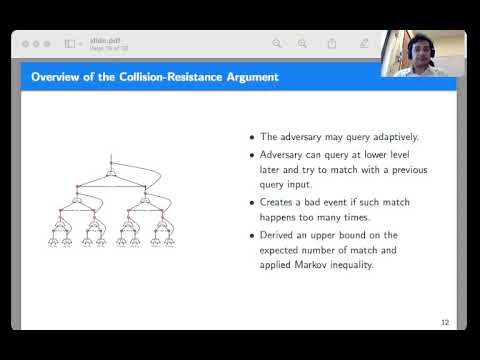CryptoDB
Compactness of Hashing Modes and Efficiency beyond Merkle Tree
| Authors: |
|
|---|---|
| Download: |
|
| Conference: | EUROCRYPT 2021 |
| Abstract: | We revisit the classical problem of designing optimally efficient cryptographically secure hash functions. Hash functions are traditionally designed via applying modes of operation on primitives with smaller domains. The results of Shrimpton and Stam (ICALP 2008), Rogaway and Steinberger (CRYPTO 2008), and Mennink and Preneel (CRYPTO 2012) show how to achieve optimally efficient designs of $2n$-to-$n$-bit compression functions from non-compressing primitives with asymptotically optimal $2^{n/2-\epsilon}$-query collision resistance. Designing optimally efficient and secure hash functions for larger domains ($> 2n$ bits) is still an open problem. To enable efficiency analysis and comparison across hash functions built from primitives of different domain sizes, in this work we propose the new \textit{compactness} efficiency notion. It allows us to focus on asymptotically optimally collision resistant hash function and normalize their parameters based on Stam's bound from CRYPTO 2008 to obtain maximal efficiency. We then present two tree-based modes of operation as a design principle for compact, large domain, fixed-input-length hash functions. \begin{enumerate} \item Our first construction is an \underline{A}ugmented \underline{B}inary T\underline{r}ee (\cmt) mode. The design is a $(2^{\ell}+2^{\ell-1} -1)n$-to-$n$-bit hash function making a total of $(2^{\ell}-1)$ calls to $2n$-to-$n$-bit compression functions for any $\ell\geq 2$. Our construction is optimally compact with asymptotically (optimal) $2^{n/2-\epsilon}$-query collision resistance in the ideal model. For a tree of height $\ell$, in comparison with Merkle tree, the $\cmt$ mode processes additional $(2^{\ell-1}-1)$ data blocks making the same number of internal compression function calls. \item With our second design we focus our attention on the indifferentiability security notion. While the $\cmt$ mode achieves collision resistance, it fails to achieve indifferentiability from a random oracle within $2^{n/3}$ queries. $\cmt^{+}$ compresses only $1$ less data block than $\cmt$ with the same number of compression calls and achieves in addition indifferentiability up to $2^{n/2-\epsilon}$ queries. \end{enumerate} Both of our designs are closely related to the ubiquitous Merkle Trees and have the potential for real-world applicability where the speed of hashing is of primary interest. |
Video from EUROCRYPT 2021
BibTeX
@inproceedings{eurocrypt-2021-30861,
title={Compactness of Hashing Modes and Efficiency beyond Merkle Tree},
publisher={Springer-Verlag},
doi={10.1007/978-3-030-77886-6_4},
author={Elena Andreeva and Rishiraj Bhattacharyya and Arnab Roy},
year=2021
}

